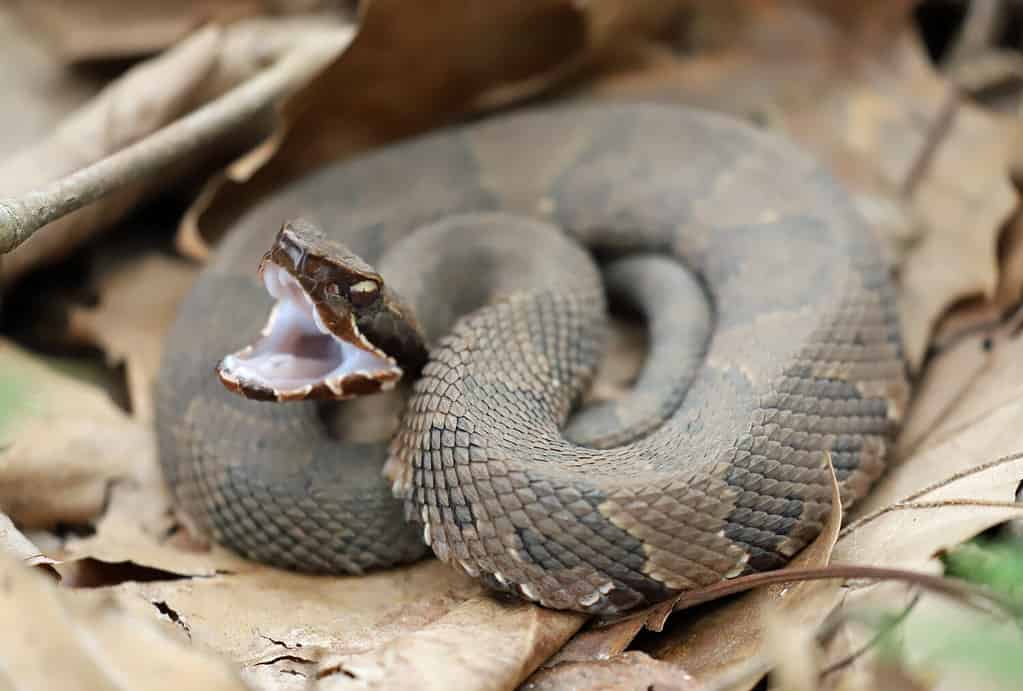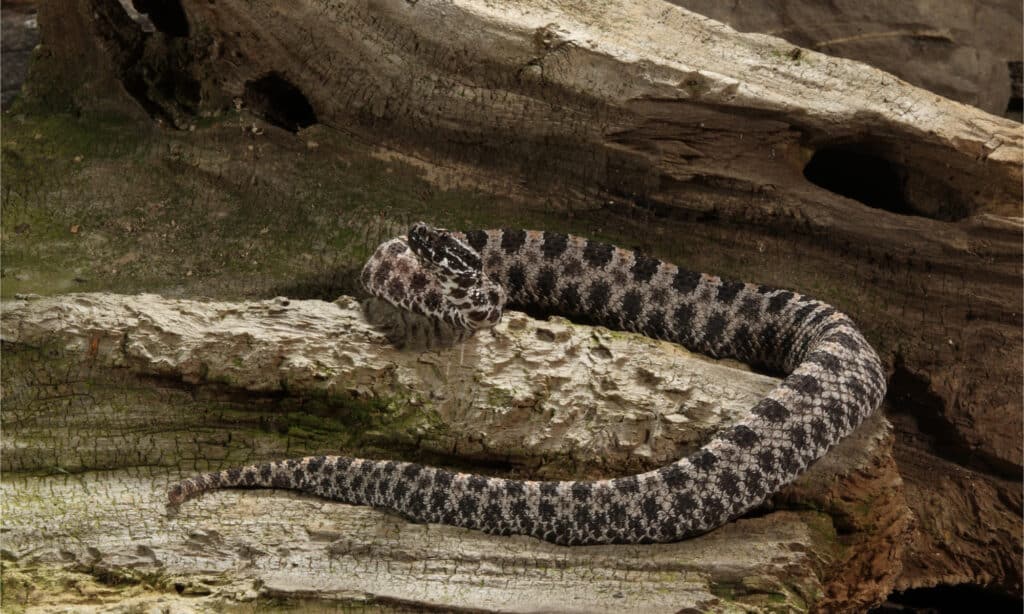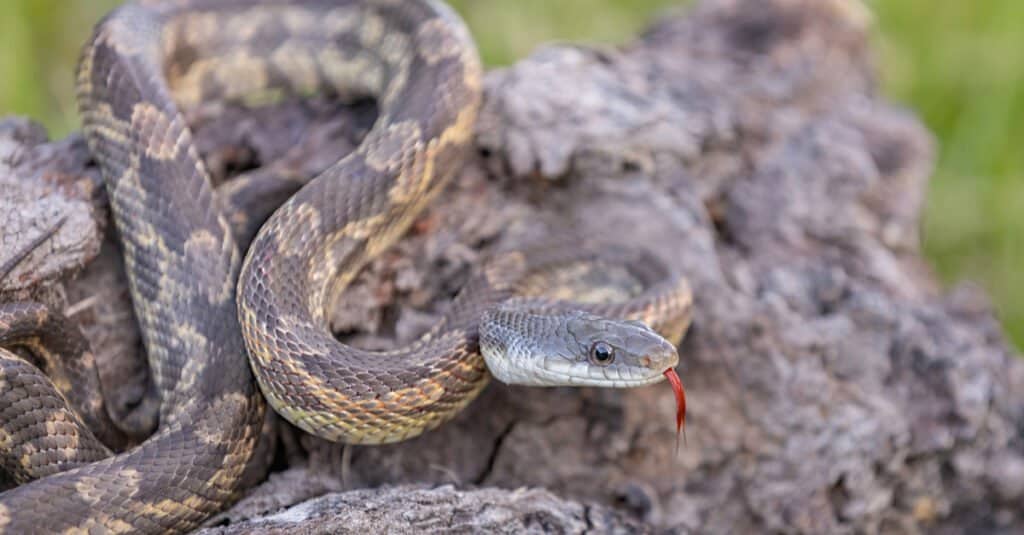As the United States’ most snake-infested state, Texas is home to 68 unique snake species! This includes many types of water snakes that inhabit lakes and rivers. Below, we’ll take a look at one of the Lonestar State’s southernmost rivers, the Nueces River, and five of its most interesting and unique snake species you may spot if you visit the area for a swim, walk, or fish. Read on to learn more about these species, where you might spot them, whether or not they’re venomous, what to do if you find one, and more.
1. Western Cottonmouth (Agkistrodon piscivorus leucostoma)

Visible here is the cottonmouth’s namesake: a bright white mouth exposed in a defense display.
©KF2017/Shutterstock.com
The western cottonmouth is the smallest subspecies of the cottonmouth snake, Agkistrodon piscivorus. It’s also one of Texas’ better-known and more common venomous snake species, particularly near clear, warm water habitats like the Nueces River. It is easily recognizable by its rather short yet thick, muscular dark brown body marked with darker brown bands that often have very thin white outlines.
Like the other two cottonmouth subspecies, the western variety gets its common name from its bright white mouth, which it will open wide and expose when frightened. As one of the Nueces River’s smaller venomous snakes, it averages just 27 to 28 inches in length.
As a water-dwelling snake, the western cottonmouth is an adept swimmer. They generally prey on fish and avoid humans. However, they can occasionally bite an unsuspecting human swimmer or hiker if startled, stepped on, or otherwise agitated.
Despite its small size, the western cottonmouth’s bite can be quite painful and cause severe bleeding thanks to its hemotoxic venom. Fortunately, though, only around 7% of snake bites in Texas are caused by this particular snake, and deaths are extremely rare. Still, though, if you spot one at the Nueces River or elsewhere, it’s best to back away slowly and keep your distance. Be sure to get medical attention immediately for potential bites.
2. Western Pygmy Rattlesnake (Sistrurus miliarius streckeri)

Pygmy
rattlesnakes
have hemotoxic venom that can be extremely painful and prevent blood clotting.
©Dennis W Donohue/Shutterstock.com
Up next is the western pygmy rattlesnake, one of three unique subspecies of the pygmy rattlesnake. This particular variety is common throughout eastern and southeastern Texas. Like the western cottonmouth, it has a fairly short and stout body that averages just 16 to 25 inches in length. It gets its taxonomic name from naturalist and herpetologist John Kern Strecker.
Recognizable by its distinctive body pattern, the western pygmy rattlesnake generally is light off-white to copper-toned in color and marked by many dark brown to black blotches of varying sizes. Atop the head and along the sides of the face have longer, thinner blotches that more closely resemble stripes.
Also similar to that of the cottonmouth, this particular snake has hemotoxic venom that can cause severe pain and bleeding. Due to its small size, small and quiet rattle, and ability to blend in well with its surroundings, it is occasionally stepped on by hikers and swimmers. This can result in a bite, though the species is not particularly aggressive and tends to avoid human contact. As with other venomous species listed here, prompt medical attention is crucial if you have been bitten.
3. Texas Rat Snake (Pantherophis obsoletus lindheimeri)

The Texas rat snake has a gray head and a beige to light brown body marked by lots of dark brown spots.
©Silent Shoot/Shutterstock.com
Next, we’ll move away from the Nueces River’s more venomous species to explore a very common snake throughout much of Texas: the Texas rat snake. Its taxonomic-specific name, lindheimeri, is a tribute to German-American herpetologist Ferdinand Jacob Lindheimer, who collected and described the first specimen in Texas.
Despite this snake’s large size at four to five feet in length, it’s one of the Nueces River’s least dangerous snake species–to humans, anyway. While it is quite fearful of human contact, it has a ravenous appetite for rats and mice as well as a wide range of small prey animals, from birds and rodents to amphibians and lizards and their eggs. Keep in mind, though, that their behavior can vary from individual to individual. Juveniles can be especially unpredictable.
All in all, Texas rat snake bites are rare, and they generally do not need much medical attention. Texas rat snakes are non-venomous, and they hunt their prey via constriction. They can reside in a wide range of habitats and are highly adaptable, and sightings in and near the Nueces River are fairly common.
4. Plain-Bellied Watersnake (Nerodia erythrogaster)

The plain belly watersnake gets its common name from its solid whitish to cream-toned belly.
©Tyler Albertson/Shutterstock.com
Another non-venomous snake you may encounter while swimming or fishing in or near the Nueces River is the plain-bellied watersnake. As its taxonomic classification suggests, this water-dwelling snake is an expert swimmer. It also isn’t picky about the habitat it resides in, with it adapting well to rivers, swamps, lakes, creeks, and more.
This particular snake is easily recognizable by its thick, long body that is primarily light to dark brown. Contrasting its darker dorsal body color is a pale cream-toned to off-white belly. This is where the species gets its common name, as it lacks any distinctive markings. Specimens generally average between 25 and 50 inches in length.
Although this species is quite common in the Nueces River and throughout Texas’ waterways, it avoids humans and prefers aquatic prey. It is a skilled hunter, often feeding on the river’s many native fish species, like the largemouth, smallmouth, and Guadalupe basses. If you encounter one of these snakes, it will likely simply swim away, but it may bite if stepped on or otherwise agitated.
5. Diamondback Water Snake (Nerodia rhombifer)

Diamondback water snakes are generally harmless to humans, though their bites can still be painful due to their sharp teeth.
©Laurie L. Snidow/Shutterstock.com
The last snake of the Nueces River we’ll touch on here is the diamondback water snake, one of around 10 non-venomous species living in Texas. First described in 1852 by American herpetologist Edward Hallowell, the totality of its geographic range covers much of the southeastern and central United States.
As far as its appearance goes, the diamondback water snake is quite easy to recognize. Its thick, mostly dark brown body can range in color slightly, from olive green to almost black. As its common name implies, it is marked by diamond-shaped spots and dark brown bars running down its back. Its underside, meanwhile, is yellowish or cream-toned. It can grow to be fairly large, ranging from 30 to 48 inches in length.
Diamondback water snakes are extremely common throughout Texas. They are largely harmless to humans. However, they can occasionally be mistaken for venomous species like the cottonmouth or diamondback rattlesnake. Though bites are rare, they can be quite painful. This is due to the snake’s very sharp, thin teeth that are meant for gripping fish while hunting.
The photo featured at the top of this post is © Laurie L. Snidow/Shutterstock.com
Discover the "Monster" Snake 5X Bigger than an Anaconda
Every day A-Z Animals sends out some of the most incredible facts in the world from our free newsletter. Want to discover the 10 most beautiful snakes in the world, a "snake island" where you're never more than 3 feet from danger, or a "monster" snake 5X larger than an anaconda? Then sign up right now and you'll start receiving our daily newsletter absolutely free.
Thank you for reading! Have some feedback for us? Contact the AZ Animals editorial team.






